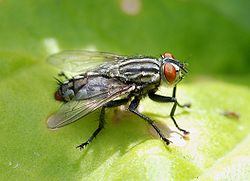- Sarcophaga africa
-
 Sarcophaga africa
Sarcophaga africa
Sarcophaga africa Classification Règne Animalia Embranchement Arthropoda Sous-embr. Hexapoda Classe Insecta Sous-classe Pterygota Infra-classe Neoptera Super-ordre Endopterygota Ordre Diptera Sous-ordre Brachycera Infra-ordre Muscomorpha selon ADW & ITIS
Cyclorrhapha selon A.Z. LehrerSuper-famille Sarcophagoidea Famille Sarcophagidae Sous-famille Sarcophaginae Tribu Sarcophagini Genre Sarcophaga Sous-genre Sarcophaga (Bercaea) Genre Sarcophaga africa
Wiedemann 1824Synonymes  Retrouvez ce taxon sur Wikispecies
Retrouvez ce taxon sur Wikispecies
D'autres documents multimédia
sont disponibles sur CommonsSarcophaga africa (Sarcophaga (Bercaea) africa) est une espèce de mouche appartenant à la famille des Sarcophagidae communément connues sous le nom de mouches à viande. C'est une des espèces les mieux connues de son genre[2]. S. africa se nourrit sur les tissus vivants et morts, y compris des escargots, d'autres matières en décomposition et les fèces[3],[2].
S. africa est une espèce synanthropique connue pour provoquer des myiases chez l'homme[4],[2] et le bétail[2]. L'espèce est considérée comme utile en entomologie légale en raison de cette qualité[5],[6]. S. Elle est coprophage, pond ses œufs dans les selles et peut être élevée à partir d'excréments humains et animaux[2]. La mouche pond aussi des œufs dans les chairs en décomposition et peut être élevée à partir de matières en décomposition[2].
Références
- (en) Cet article est partiellement ou en totalité issu de l’article de Wikipédia en anglais intitulé « Sarcophaga africa » (voir la liste des auteurs)
- Biological Library, 2008-09-15. Consulté le 2009-12-22
- (en) G. M. Baker, Natural Enemies of Terrestrial Molluscs, Wallingford, Oxfordshire, UK, CABI Pub., 2004 (ISBN 978-0-85199-319-5) (LCCN 2003022779)
- S Pérez-Moreno, « Comparative morphology of early stages of two Mediterranean Sarcophaga Meigen, 1826 (Diptera; Sarcophagidae) and a review of the feeding habits of Palaearctic species », dans Micron, vol. 37, no 2, 2006-02, p. 169–179 [lien PMID, lien DOI (pages consultées le 22 décembre 2009)]
- Aggrawal's Internet Journal of Forensic Medicine and Toxicology, 2004
- Development of DNA-Based Identification Techniques for Forensic Entomology. Phase 2
- K. A. K.A. Williams, « A history of southern African research relevant to forensic entomology », dans South African Journal of Science, vol. 102, January/February 2006, p. 59–65
Liens externes
- Référence NCBI : Sarcophaga africa (en)
Catégories :- Diptère (nom scientifique)
- Sarcophagidae
Wikimedia Foundation. 2010.
